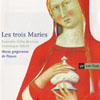(Les) Trois Marie
A mostly convincing realisation of this lively Easter liturgical drama, with very fine performances throughout
View record and artist detailsRecord and Artist Details
Composer or Director: Anonymous
Label: Virgin Classics
Magazine Review Date: 9/2000
Media Format: CD or Download
Media Runtime: 67
Mastering:
DDD
Catalogue Number: 545398-2

Tracks:
| Composition | Artist Credit |
|---|---|
| (Les) trois Maries |
Anonymous, Composer
Anonymous, Composer Dominique Vellard, Conductor Ensemble Gilles Binchois |
| Messe de Pâques |
Anonymous, Composer
Anonymous, Composer Dominique Vellard, Conductor Ensemble Gilles Binchois |
| Exultet |
Anonymous, Composer
Anonymous, Composer Dominique Vellard, Conductor Ensemble Gilles Binchois |
Author: mberry
These performers are an ideal group for this music. Written in all probability for a community of Benedictine nuns, this 14th- century Easter drama was composed in Latin with snatches of French vernacular. After a quiet masculine rendering of an (abbreviated) version of the Salisbury Exultet, the women’s voices, bright and clear, take over the telling of the story in a conflation of various episodes featuring the three Maries. On their way to the tomb, they pause to barter elegantly with the merchants for the finest oils. Each scene is heralded by a discreet chime of the bell, corresponding to the tracks on the CD (NB: track 6 is announced a little too soon in the booklet). The discovery of the empty tomb occasions the dialogue between the Angels and the Maries. After Madeleine’s lament there is a wonderful scene between herself and Jesus, culminating in his exclamation ‘Maria!’ and her enraptured response ‘Rabboni!’. To the request for news from the two disciples, Peter and John, the Maries reply with fragments from the Easter sequence Victimae paschali laudes. The drama ends with cries of joy and victory, and the Easter Mass starts immediately with the troped Introit.
The singers follow other manuscripts for the proper chants of the Easter Mass, in particular a 10th-century Graduale from Laos, MS 239. Dominique Vellard has been foremost in demonstrating a plausible interpretation of its precious notational indications: his contribution in this area has been inestimable, a splendid example being the Easter Alleluia Pascha nostrum recorded here. It means, of course, that on this CD the Mass chants do stand out rather starkly as being from a much earlier period, and that taken with the 13th-century English version of the Exultet, the three sections of the programme represent a huge slice of chant history. Marie-Noel Colette brings the three together in her excellent note.'
The singers follow other manuscripts for the proper chants of the Easter Mass, in particular a 10th-century Graduale from Laos, MS 239. Dominique Vellard has been foremost in demonstrating a plausible interpretation of its precious notational indications: his contribution in this area has been inestimable, a splendid example being the Easter Alleluia Pascha nostrum recorded here. It means, of course, that on this CD the Mass chants do stand out rather starkly as being from a much earlier period, and that taken with the 13th-century English version of the Exultet, the three sections of the programme represent a huge slice of chant history. Marie-Noel Colette brings the three together in her excellent note.'
Discover the world's largest classical music catalogue with Presto Music.

Gramophone Digital Club
- Digital Edition
- Digital Archive
- Reviews Database
- Full website access
From £8.75 / month
Subscribe
Gramophone Full Club
- Print Edition
- Digital Edition
- Digital Archive
- Reviews Database
- Full website access
From £11.00 / month
Subscribe
If you are a library, university or other organisation that would be interested in an institutional subscription to Gramophone please click here for further information.




